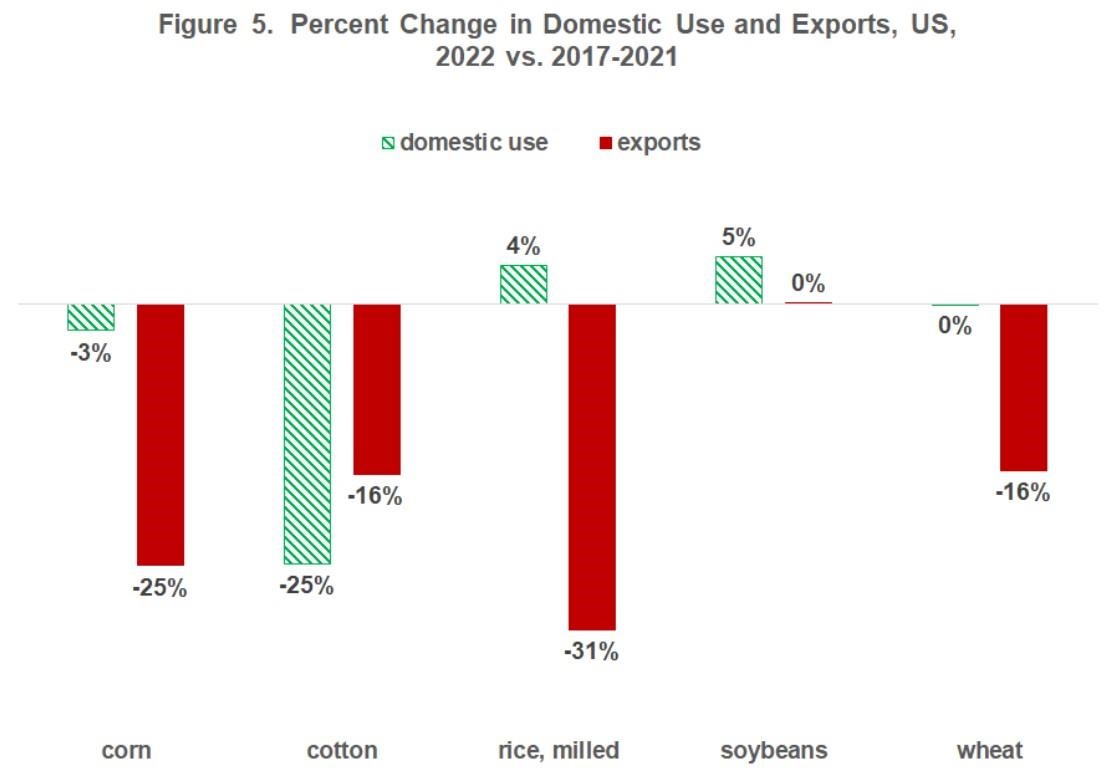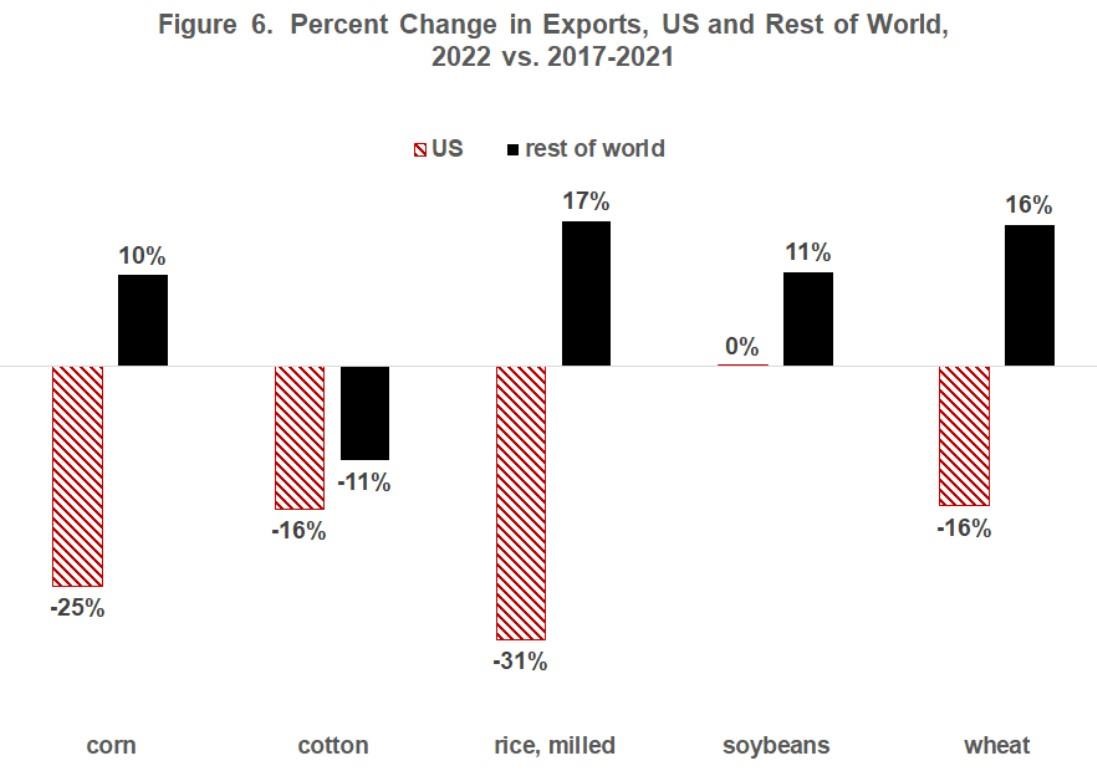By Gary Schnitkey
Department of Agricultural and Consumer Economics
University of Illinois
By Carl Zulauf
Department of Agricultural, Environmental and Development Economics
Ohio State University
We analyze the risks of not covering total cost during the 2023 production year for corn and soybeans grown on high-productivity farmland in central Illinois. There are relativity high probabilities that costs will not be covered on cash rented farmland. Still, financial stress likely will not result in 2023. However, lower prices in the summer of 2023 could signal the need to adjust for 2024 production.
Total Costs and Margins
Figure 1 shows the calculation of total costs and break-even prices for high-productivity farmland in central Illinois. According to the 2023 Illinois Crop Budgets, non-land costs for corn are $858 per acre for corn and $532 for soybeans (See Table 1). With a cash rent of $370 per acre, total costs are $1,228 for corn and $902 for soybeans.

Over time, farmers require a margin above total costs to cover family living, replay debt, and make capital purchases. For the example in Figure 1, we use a margin of $75 per acre. For a 1,500-acre farm, that margin would result in $112,500 of net farm income from grain operations. For the ten years from 2012 to 2021, net income on Illinois grain farms averaged $160,000 per farm (farmdoc daily, November 15, 2022). Total cost plus a $75 margin equals $1,303 per acre for corn and $977 for soybeans (see Figure 1).
Break-even Prices
In this article, we calculate two break-even prices: 1) break-even to cover total costs and 2) break-even to cover total costs plus a margin. The yield used in calculating break-even is the expected yield. At this point, there is little reason to vary from the expected yields. We then compare those break-evens to the chances of having prices below those break-evens from our Price Distribution Tool (available here). These probabilities will quantify the risks of not covering total costs and margins.
For corn, the break-even price to cover total costs is $5.34 per acre (see Figure 1). The break-even price to cover total costs plus margin is $5.67 per bushel. Recently, prices related to the 2023 harvest have declined. For example, prices on the December Chicago Mercantile Exchange (CME) corn contract averaged $5.90 during February, resulting in a projected price of $5.90 for crop insurance purposes. Currently, the December contract is trading at $5.60. In addition, cash prices for 2023 fall delivery have declined from $5.60 in February to $5.25 in April.
The Price Distribution Tool was used to calculate the chances of prices being below the $5.34 break-even price to cover costs (i.e., a December price of $5.64 given a -$.30 basis). These comparisons were retrieved on April 10. Chances will change as market conditions changes. The chance of being below the $5.34 break-even price is 55%. The probability of being below the $5.67 break-even to cover total costs plus margin is 66%.
For soybeans, the break-even price is $12.53 per bushel for total costs and $13.57 for total costs plus a margin. Similar to corn, soybean prices have declined. For example, prices of the November CME contract during February averaged $13.76, resulting in a projected price for crop insurance of $13.76. The November CMT soybean contract is at $13.10. . In addition, cash prices for 2023 fall delivery have declined from $13.40 in February to $12.70 in April.
We again used the Price Distribution tool on farmdoc to assess the probability of being below break-even levels. For soybeans, the likelihood of being below $12.83 is 47%. The possibility of being below the $13.57 break-even price is 69%.
Minimum Cash Guarantees from Crop Insurance
Table 1 shows minimum cash guarantees from crop insurance given that Revenue Protection (RP) was purchased. The minimum cash guarantee is lower than the stated crop insurance guarantee because cash prices are lower than futures prices. The projected price for crop insurance is based on futures prices. A $.30 basis is used for both corn and soybeans. Also, note that the minimum cash guarantee for RP is the cash guarantee for RP with the harvest price exclusion. Guarantees will increase for RP if harvest prices are above projected prices. RPhpe guarantees do not increase.
An 85% RP policy has a minimum cash guarantee of $1,097 per acre (see Table 1 and farmdoc daily, March 7, 2023). Minimum cash guarantees decrease as coverage declines: $1,030 for 80% RP and $966 for 75% RP. The minimum guarantee for soybeans is $824 at an 85% coverage level, reducing to $727 per acre for a 75% coverage level.

At the highest coverage level of 85%, total costs exceed the minimum cash guarantees. For corn, $1,228 per acre of costs is $131 per acre higher than the $1,097 guarantee. For soybeans, $902 in costs is $78 per acre higher than the $824 guarantee at the 85% coverage level.
Significant losses will occur for corn and soybeans before crop insurance makes payments on cash rented farmland.
Commentary for 2023 incomes
Current market conditions suggest a significant chance of loss in 2023 on cash rented farmland. There is a 57% chance of being unable to cover corn costs and a 47% chance for soybeans.
We are just beginning the growing season in North America, and much can influence prices and yields. Factors include:
- Production in South America. Overall, South American soybean production is expected to exceed previous year’s levels, with notable differences in Brazil and Argentine production (farmdoc daily, March 31, 2023). Large plantings of safrina corn are expected, with yields unknown at this point
- A good growing season in North America could result in lower prices. Lower revenue may result, but higher yields could offset lower prices. Conversely, a poor growing season could result in higher prices. From a revenue standpoint, lower yields could offset those higher prices.
- Other supply and demand could significantly impact prices, just as the Ukraine-Russia conflict positively impacted prices last year. Those events are unpredictable at this point.
While the chance of negative returns is possible, there are three reasons to believe that financial stress will be minimal if those poorer returns do occur:
- Crop insurance does provide significant downside protection, and most farmers in central Illinois purchase crop insurance at high coverage leaves.
- The above break-even are based on cash rent farmland. Many farms have significant amounts of owned farmland. If debt levels are low on that owned farmland, financing costs will be low, potentially leading to lower break-even prices. Similarly, share rent farmland will have lower break-evens.
- Most farmers had positive incomes in recent years, resulting in more financial strength. That financial strength could be used to backstop poorer 2023 incomes if they occur.
- There also is a possibility of additional ad hoc disaster assistance. From 2017 to 2021, additional disaster assistance has been provided through Congressional resolutions, including Wildfire Hurricane Indemnity Program Plus (WHIP+) programs in 2018 and 2019 and the Emergency Relief Program (ERP) in 2020 and 2021. Those programs have topped up crop insurance coverage. However, there is no guarantee those programs will occur, and it would require Congressional action to institute those programs in 2022 and 2023.
We do not expect commodity title programs to provide payments for 2023 production (see farmdoc daily, January 24, 2023). Price Loss Coverage (PLC) and Agricultural Risk Coverage (ARC) adjust to higher market prices, but due to lags in prices entering calculations, those adjustments will not occur until 2024. Prices would have to be below $3.70 for corn and $8.40 for soybeans for PLC to make payments. ARC benchmark prices are $3.98 for corn and $9.57 for soybeans.
Returns for 2023 will become clearer toward late summer when 2023 yields and prices are more certain, leading to more accurate estimates of 2023 returns. Late summer will also be the point when 2024 prices will begin to be forecasted with some accuracy. If 2024 forecast prices are below $5.00 for corn and $12.25 for soybeans, serious adjustments will need to be considered for 2024 production, particularly if input costs remain high. Lowering cash rents may need to be considered. If input costs do not decline, prices below $5.00 for corn and $12.25 for soybeans will result in unprofitable projections for 2024.
Still, those concerns are in the future. Much will depend on growing conditions and supply and demand factors from now until the end of 2023.
Source : illinois.edu